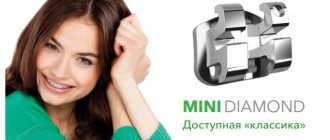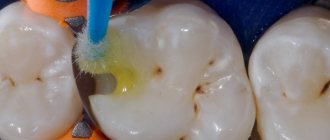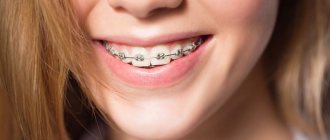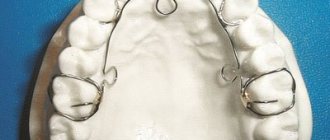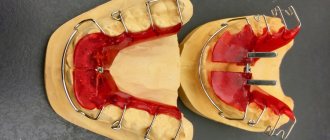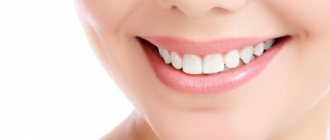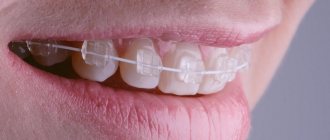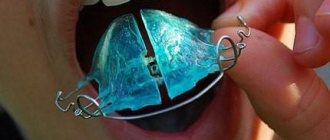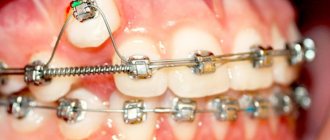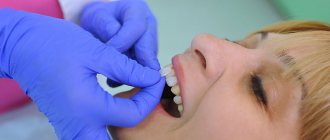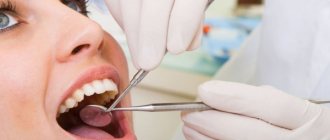Braces are metal clasps that are attached to the teeth. But they themselves do not correct the position of the teeth - the braces system does this. The main element of the system is the arc. It is this that affects the teeth, causing them to move. To do this, the arch is changed several times during the treatment process.
Arches for braces are made of a metal alloy. Most often it is nickel and titanium or titanium and molybdenum. At the request of the patient, you can choose an arch with a white coating - it visually goes well with ceramic or sapphire braces and is almost invisible. True, the white coating wears off quickly, so such an arch can be considered more as an option for a special occasion, for example, a wedding or graduation.
With a white arch, transparent braces are almost invisible
Basic properties of the arc:
- Strength. Braces can come off from the teeth, especially if you do not follow the rules of nutrition (gnaw nuts, crackers). But it is almost impossible to break or bend the arc.
- Flexibility and resilience. Regardless of what position the arch takes, it will tend to its original shape, similar to half an oval (except for the arch of lingual braces - it repeats the shape of the regular dentition not from the outside, but from the inside, so it looks different).
No matter how bent the arch is at the beginning of treatment, it tends to return to its shape
- Hypoallergenic. The arc is made of a material that does not cause allergies and a metallic taste in the mouth. It is not magnetic and does not “ring” at the airport when going through security.
The orthodontic arch is the main one in the design of the bracket system
The classic version of the braces system includes:
- Braces are miniature plates made of metal, ceramic or medical sapphire, fixed to the surface of the enamel with a special adhesive composition. Each bracket has a slot for the archwire.
- An orthodontic arch is a metal wire that passes through the grooves of the braces and connects the plates into a single corrective system. The arch provides uniform traction and pressure to move the teeth.
- Ligatures are elastic rubber rings for attaching the arch in the grooves of braces. In non-ligating (self-ligating) systems, special locks are responsible for fixing the wire.
In case of serious malocclusion pathologies, the design of metal braces is reinforced with additional elements to improve the quality and speed of treatment.
How does the replacement work?
There are two indications for arch replacement:
- planned - during treatment;
- urgently - in case of breakdowns of this structural element.
Planned replacement is needed to increase or decrease pressure in accordance with the treatment plan. Replacement occurs quite quickly: 10-15 minutes are enough for upper and lower braces.
Breakage is possible due to injury, impact or other sudden mechanical impact. This is rarely observed, since all the materials from which the arcs are made are quite durable. If a breakdown does occur, the arch is replaced in the shortest possible time with one identical in degree of rigidity.
Before replacing, the doctor opens the locks or removes the ligatures (depending on the type of system). Using special tweezers, the old arc is removed from the grooves, and a new one is installed in the vacant space, which is fixed with fasteners in the grooves.
The principle of operation of braces for correcting malocclusion
- Based on the treatment plan, the orthodontist sets the orthodontic arch to the correct position of the patient’s dentition.
- After being fixed in the grooves of the braces, the metal wire tends to return to the specified reference position and pulls the teeth along with it.
- During the treatment, the power parts are changed and activated, increasing the pressure on the crowns and root system.
- The gradual movement of dental units forms the patient’s correct bite.
During the correction process, Aza&Buka orthodontists adhere to certain rules:
- Thin arc elements are installed first. Treatment begins with a weak impact so that the patient adapts to the orthodontic structure and does not experience severe pain.
- The load is increased gradually, increasing traction and pressure. The arches are changed to stiffer and thicker ones.
How is crooked teeth corrected?
Each bracket is attached with a special composite adhesive to the surface of the tooth. This is a very crucial moment responsible for achieving a positive result. The way your doctor attaches the brackets affects the tooth's ability to move in a given direction. The pressure of the arch product is transferred to the brackets, allowing you to “control” the teeth.
It may seem that an orthodontic archwire is a simple wire. But this is absolutely false. The design, depending on the profile, tension force and cross-section, is designed to solve certain problems.
The structures are attached to the root teeth, and the brackets are attached to them using ligatures.
How strongly the wire will press on the teeth is determined by its fastener diameter and cross-section. The purpose of each set of arc products is different. Therefore, the groove into which the fastening element is threaded must have a specific slot direction for each element.
Types of arches for braces
The diameter and cross-sectional shape of the orthodontic arch are selected for each stage of treatment. The thinner the wire, the more gentle the effect. Correction of the bite begins with the installation of thin movable arches. Both parameters are taken into account simultaneously:
- Round cross-section with a diameter of 0.14-0.18 inches. Wires with low rigidity, increased elasticity and good mobility. Suitable for starting treatment - painless adaptation and getting used to the metal brace system.
- Arcs with a rectangular cross-section of 0.14-0.25 inches. Installed during the main period of correction - they provide an intense impact, are responsible for changing the shape of the dentition and moving individual units.
- Square cut arc with dimensions of 0.16-0.175 inches. The wire has maximum resistance - it does an excellent job of final alignment of the bite and creating correct occlusal contacts.
Orthodontic arches for braces are divided into:
- By purpose - for upper and lower teeth (Ulilier / Lower), for vestibular and lingual braces, universal.
- By size, taking into account the size of the teeth - large, medium, small.
Correction stages
The orthodontist determines the stages of treatment individually in each case, observing the dynamics of the process. But there are standard recommendations that the dentist relies on. In accordance with them, treatment is divided into three main stages:
- The first is to install highly elastic arches with a small cross-section. This is necessary in order to launch the initial mechanisms of teeth movement in the desired direction.
- The second is that corpus movement occurs, that is, the movement involves not only the crown part of the tooth, but also the root. For this purpose, thick arches with a large cross-section and increased rigidity are used. Usually they fill almost the entire space of the groove.
- The third is consolidation of the result. The middle section is used so that the speed of the process gradually slows down and returns to normal.
Materials for the manufacture of orthodontic arches
For the manufacture of arch elements of bracket systems, the following metals are used:
- Stainless steel. Steel arc is a classic option. Advantages: versatility, low cost, good rigidity, strength and elasticity.
- Alloy of titanium and nickel. Wire with increased elasticity for bite correction in the first months of treatment. Advantages: moderate pressure on teeth, reduced frequency of arch replacement.
- An alloy of titanium, nickel and copper. Elements with high quality characteristics. Suitable for correcting minor malocclusions.
- Titanium alloy with molybdenum. Hypoallergenic material – hard and elastic. Necessary for creating strong pressure and displacement of teeth at the main stage of orthodontic treatment.
Arc elements made of steel are produced:
- Monolithic - made from a single piece of wire. Recommended in the middle or final stages of orthodontic correction.
- Braided - from 4-6 pieces of thin metal. Installed during the adaptation period of wearing braces.
Duration of treatment and frequency
Practice shows that correcting occlusal defects and adjusting the position of defective elements of the dentition, based on the degree of development of the pathology, takes from one and a half to two and a half years. For each case, the period is determined individually, and its duration is influenced by factors such as:
- Condition of the bone structure;
- Patient's age;
- Intensity of tooth displacement;
- Compliance with medical recommendations.
When drawing up a treatment plan, the frequency of visits to the orthodontist is determined in advance. During each visit to the clinic, the dynamics of the correction are assessed, and changes necessary to achieve the desired result are made. One of these manipulations is the planned replacement of the bracket arch.
The metal arc is an integral element that is replaced at least 3-4 times during the course of treatment. The longer the assigned correction duration, the more often the update is carried out. The purpose of the procedure is to install a more rigid structure that exerts the necessary force pressure on the dentition.
Special arches for bracket systems: with white coating, with loops and others
In pediatric dentistry, Aza&Buka uses arc elements of a complex design:
- with loops - for closing interdental spaces that arise after the removal or loss of individual units;
- with a reversal bend along the curve of Spee - when it is necessary not only to align the teeth, but also to change the depth of the bite;
- with hooks or stops - for fixing elastics and springs when eliminating serious bite pathologies;
- with white coating – arches for ceramic and sapphire bracket systems with a special coating.
Application in orthopedics
A facial bow in orthopedics eliminates inaccuracies in the manufacture of various structures and helps to correctly transfer the anthropometric data of each patient. It is used in various types of prosthetics, from single crowns to total work with complete or partial loss of teeth, for the manufacture of veneers and crowns.
There are two types of orthopedic face bows:
- Standard or average anatomical - most often used for the manufacture of removable dentures. This facebow consists of a hinge, a frame, a nose piece and a bite fork. All these parts are connected together and fixed to each other, and then attached to the anatomical structures of the head: the frame to the ears, the nose pad to the bridge of the nose, and the bite fork to the teeth of the upper jaw. If the patient has no teeth, a special template is used.
- Kinematic - selected when it is necessary to manufacture partial dentures. Unlike the standard one, the kinematic facebow does not have a frame and is not fixed in the ears; it is attached to the chin and bridge of the nose.
After the silicone has hardened, the bite fork is removed from the oral cavity, then the model of the upper jaw is plastered in the articulator on the transfer table, and the model of the lower jaw is plastered to the upper jaw. This is how the articulator forms the correct position of the jaws relative to each other, which orthopedists use to model teeth, make veneers and crowns, dentures and other structures supported by teeth and implants. Thanks to this approach, we achieve the best aesthetic parameters of a smile.
Sticking archwire and other problems with braces
During the process of orthodontic treatment, patients are forced to endure some inconvenience and discomfort. Main complaints and solutions.
- Injury to the oral mucosa. During the adaptation process, metal elements scratch the inner surface of the cheeks and lips. To reduce the intensity of the impact, protruding elements are blocked with pieces of wax. After adaptation to braces, pain disappears.
- The tip of the braces arch protrudes and hurts the cheek. During the correction process, a situation often arises when the power part is lengthened. This leads to the fact that its tip begins to protrude beyond the bracket and injure the mucous membrane. A ball of wax for braces on the edge of the arch or contacting an orthodontist to remove excess wire can solve the problem.
- Damage to the corrective element. This is possible under intense chewing loads or as a result of mechanical stress. The situation can be corrected by replacement. To do this, you need to contact your treating orthodontist.
Most common problems
There are different cases when wearing braces. The arch may break off as a result of improper use of the structure or the use of the wrong material for its manufacture, fly out of the last bracket, and so on. What to do in this case? Let's look at each situation in more detail:
- The last lock of the bracket does not fix the arch very firmly, for this reason the structure may fall out of it. But this is no reason to worry. There is no need to change the design. And the patient can reattach it independently. Standing in front of the mirror and using tweezers, you can carefully insert the end of the wire into the hole in the lock. Try to be as precise as possible.
- It is also possible for the arch to bulge and cause injury to the soft tissues of the oral cavity. The case is unpleasant, and to solve it you need the help of an orthodontist. He will either replace the structure or simply trim the ends of the wire.
- If a wire falls out of a lock that is not the last one, you also need to contact a specialist. And as early as possible. After all, this is how the arc changes its position and can ruin the entire treatment process.
- If the arc breaks, it can only be replaced. Again, only an orthodontist can do this. Before visiting him, you can protect the soft tissues of the oral cavity by treating the protruding edge of the wire with wax.
Recommendations of orthodontists Aza&Buka
High-quality orthodontic treatment with braces requires a responsible approach from patients:
- You cannot skip scheduled appointments. Otherwise, the effectiveness of treatment decreases and the length of correction time increases.
- It is unacceptable to independently replace the wire in metal or other braces. Despite its apparent simplicity, the procedure requires accuracy and precise medical calculations.
- Correct selection of products during the treatment period. You need to avoid solid foods that can deform or break the elements of the braces system.
Replacement frequency
The frequency of replacement corresponds to the stages of treatment. In the case of a simple correction, this can happen once: a more elastic and thinner one changes to a thicker one. Each of them will be used for several months. In most cases, three replacements are provided: during installation, in the middle of the course and at the last stage.
If the patient has complex disorders of the dental system, the number of replacements increases. The orthodontist determines this need and frequency. If restoration of the bite takes years, then the number of replacements increases many times.
The reception is being conducted
Storchakova Zhanna Ardashesovna Doctor of the first category, 9 years of experience.
The nearest admission date is 12/30/2021
Doctor rating
Cost of admission
1750 rub.
1400 rub.
* price when registering online The price includes: examination, OPTG, drawing up a treatment plan.
Phone numbers for recording
+7(495)500-93-90
Schedule for Thu, 30 Dec.
Price
| Appointment with an orthodontist (examination, consultation, OPTG) | 500 |
| Diagnosis before orthodontic treatment | 2000 |
| Drawing up an orthodontic treatment plan | 1700 |
| Taking an impression | 330 |
| Casting a diagnostic model | 230 |
| Oral hygiene training | 130 |
| Model calculation | 550 |
| Teleradiogram analysis | 110 |
| Orthopantogram analysis | 60 |
| Correction of malocclusions and teeth position using the Persin Apparatus | 20000 |
| Correction of malocclusions and teeth position using Frenkel Activator (types 1,2,3) | 20000 |
| Correction of malocclusions and tooth position using the Andresen-Goipl Apparatus | 17050 |
| Correction of malocclusion and tooth position using a plate (on one jaw) with 1 screw | 10000 |
| Correction of malocclusions and tooth position using a plate (on one jaw) with 2 screws | 11550 |
| Correction of malocclusion and tooth position using a plate (on one jaw) with a Bertoni screw | 13500 |
| Inclined plane | 900 |
| Separation in the lateral sections | 900 |
| Bites area | 900 |
| Lip pilot | 1350 |
| Correction of malocclusions and tooth position using a simple plate (on one jaw) | 8000 |
| Artificial tooth | 500 |
| TWIN-block (with screw) | 20000 |
| Treatment using a positioner | 20000 |
| Treatment using an elastopositioner | 52800 |
| Repairing a removable device | 2200 |
| Observation, correction of removable appliance (once a month) | 5500 |
| Making a wax template with bite ridges to determine the constructive bite | 880 |
| Muppy vestibular plate with bead | 7000 |
| Muppy vestibular plate with flap | 7000 |
| Muppy vestibular plate with visor | 7000 |
| Muppy vestibular plate standard | 5000 |
| Spacer for 1 tooth | 6000 |
| Haas apparatus according to Mark Ross with fixation on 2 rings | 25000 |
| Haas apparatus with fixation on 4 rings | 27000 |
| Derichsweiler apparatus with screw fixation on 4 rings | 27000 |
| Derichsweiler apparatus with screw fixation on 2 rings | 25000 |
| Treatment using a trainer | 13750 |
| Treatment using LM activator | 13750 |
| Manufacturing and fixation of a retention plate (1 row of teeth) | 7150 |
| Manufacturing and fixation of a mouth guard retainer (1 row of teeth) | 4950 |
| Set-up (rearrangement of 1 tooth) | 440 |
| Manufacturing and fixation of a non-removable wire retainer (1 tooth row) | 3850 |
| Repairing a retainer | 2200 |
| Mouth guard for bruxism | 9900 |
| Boxing tire | 13200 |
| Removing the retainer (1 tooth) | 350 |
| Self-ligating metal braces QUICK (Germany) 1 row of teeth | 32450 |
| Self-ligating metal braces QUICK (Germany) 1 pc. | 2650 |
| Self-ligating ceramic + metal braces QuickKlear (Germany) 1 tooth row | 52800 |
| Self-ligating ceramic + metal braces QuickKlear (Germany) 1 pc. | 5500 |
| Ligature ceramic braces Aspire (Germany) 1 row of teeth | 39600 |
| Ligature ceramic braces Aspire (Germany) Clarity Advanced 1 piece | 4500 |
| Ligature metal braces Sprint (Germany) 1 row of teeth | 27500 |
| Ligature metal braces Sprint (Germany) 1 pc. | 3300 |
| Ligature sapphire braces Aesthetik (Germany) 1 row of teeth | 36300 |
| Ligature ceramic braces Aspire Clarity (Germany) 1 tooth row | 36300 |
| Ligature sapphire braces Aesthetik (Germany) 1 pc. | 4070 |
| Self-ligating metal braces “Damon Q” (USA) 1 tooth row | 37400 |
| Self-ligating metal braces “Damon Q” (USA) 1 pc. | 4200 |
| Self-ligating ceramic + metal braces “Damon clea” (USA) 1 tooth row | 60500 |
| Self-ligating ceramic + metal braces “Damon clea” (USA) 1 pc. | 6000 |
| Self-ligating ceramic + metal braces “In-Ovation S” (USA) 1 dentition | 51700 |
| Self-ligating ceramic + metal braces “In-Ovation S” (USA) 1 pc. | 6000 |
| Self-ligating metal braces “In-Ovation R” “Victory SL” 1 tooth row | 31350 |
| Self-ligating metal braces “In-Ovation R” “Victory SL” 1 pc. | 3630 |
| Ligature sapphire braces INSPIRE (USA) 1 row of teeth | 49500 |
| Koboyazh (1 piece) | 170 |
| Buccal tube (1 piece) | 2200 |
| Re-fixation of one bracket (without bracket) | 550 |
| Fitting the ring for fixing the arc | 2200 |
| Re-fixing the tube | 1350 |
| Fitting the orthodontic button | 1210 |
| Removing a metal bracket (cleaning, polishing) 1 tooth | 300 |
| Removing a ceramic bracket (cleaning, polishing) 1 tooth | 500 |
| Removal of sapphire bracket (cleaning, polishing) 1 tooth | 550 |
| Changing a metal/elastic ligature for 1 row of teeth | 550 |
| Changing the arc during treatment stages | 1650 |
| Changing the “Aesthetic” arch during treatment stages | 2420 |
| Changing the arch with loops at treatment stages | 2750 |
| Tooth separation (1 tooth) | 220 |
| Bite separation using composite materials (occlusal overlays) | 1100 |
| Chain change (one link) | 110 |
| Elastic rings (one pack) | 600 |
| Installing the opening spring | 1100 |
| Installing the closing spring | 1210 |
| Orthodontic wax (one package) | 440 |
| Separation ring (1 piece) | 60 |
| Orthodontic hooks for installation on Damon Q brackets (1 piece) | 220 |
| Dental container | 600 |
| Repeated appointment (Metal self-ligating braces) | 4000 |
| Re-appointment (Ceramic self-ligating braces) | 5000 |
| Repeated appointment (Metal ligature braces) | 5000 |
| Repeated appointment (Ceramic ligature braces) | 6000 |
| Repeated appointment (Sapphire ligature braces) | 6500 |
| Repeated appointment (Metal + ceramic self-ligating braces) | 4500 |
| Repeated appointment (Metal + ceramic ligature braces) | 5500 |
| Device "JASPER JAMPER", "JET", "DISTAL JET" | 26000 |
| Device "FORSUS" | 30000 |
| Device "PENDEX", "PENDULUM" | 27000 |
| TWIN FORCE | 26000 |
| NANSA button | 14000 |
| Full course (includes: virtual 3D plan, 3 3D plan corrections, up to 50 stages) | 300000 |
| Short course (includes: virtual 3D plan, no more than 12 stages) | 160000 |
| Treatment of one jaw (includes: virtual 3D plan, unlimited number of stages, 2 corrections) | 160000 |
| Super-short course of up to 5 stages (includes: virtual 3D plan, no more than 5 aligners per jaw) | 85000 |
| Preparation for implantation (includes: virtual 3D plan, for more than 5 aligners per jaw) | 85000 |
| Super-long course (includes: virtual 3D plan, 4 corrections, more than 50 stages) | 350000 |
| 3D plan (when you subsequently order aligners according to the paid 3D plan, the amount paid for it is deducted from the cost of the course) | 45000 |
Why might I experience discomfort or pain after getting braces?
The arches that are used on the bracket system at the beginning of orthodontic treatment have shape memory. Therefore, no matter what bend the arch placed in the groove from the braces makes, it tries to return back to its original position, thereby affecting the position of the teeth and straightening them. Unpleasant sensations that occur immediately after installing braces can most often be associated with the fact that constant tension develops inside the bone due to the work of the arch. Adaptation of the ligaments of teeth in the upper jaw occurs within 3-5 days in adolescents and after 7-10 days in adult patients. The bone tissue on the lower dentition is denser, which is why addiction can last up to 10-12 days in adult patients, and up to 7 days in adolescents.
Another reason for discomfort after installing a brace system is irritation of the mucous membrane of the tongue (if internal lingual braces are used) or lips, cheeks (if external braces are used). In the process of talking, chewing, and swallowing, the cheeks and teeth produce movement, so the protruding parts of the braces system, which are constantly in contact with the mucous membrane, lead to “rubbing.” The human body is a wise system, therefore, in response to regular irritation on the mucous membrane in the place where there is contact with braces or locks, a “protective stratum corneum” is formed, which in open areas of the skin is similar to a callus, so there is a gradual decrease in sensitivity. However, if you remove the irritant - in this case, the braces system - the mucous membrane is restored.
